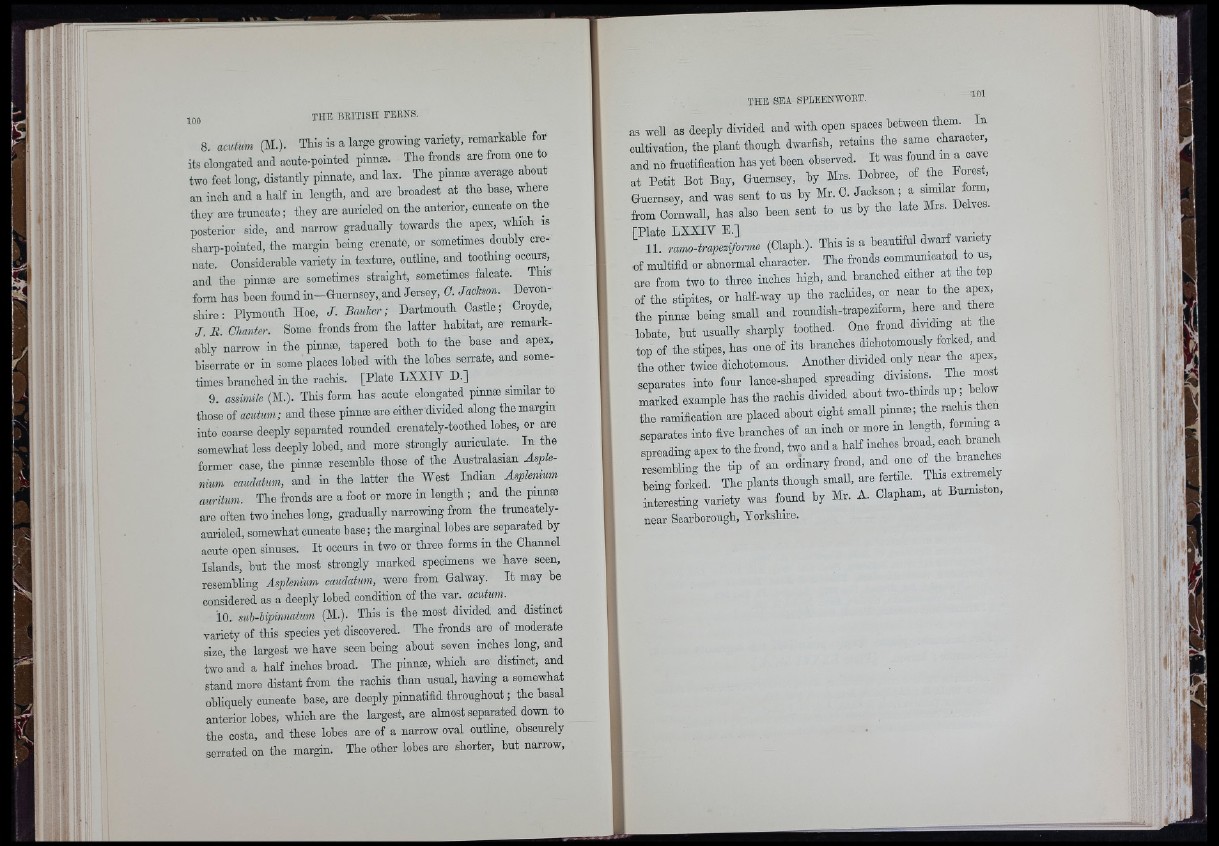
V? î:
I;
i:
100 the BEITISH FERNS.
8. amtmn (M.). This is a large gromng variety, remarkable for
its elongated and acute-pointed pinnæ. Tho fronds are from one to
two feet long, distantly pinnate, and lax. The pinnæ average about
an inch and a half in length, and are broadest at the base, where
they are truncate ; they are auricled on the anterior, ouneate on the
posterior side, and narrow gradnaUy towards the apex, which is
sharp-pointed, the margin being crenate, or sometimes doubly ore-
nate. Considorable variety in texture, outline, and toothing ooonrs,
and the pinnæ aro sometimes straight, sometimes falcate. This
form has been found in—Guernsey, and Jersey, C. Jackson. Devonshire
: Pl}Tnouth Hoe, J. Banker ; Dartmouth Castle ; Croyde,
J. B. Chanter. Some fronds from the latter habitat, are remar i-
ably narrow in the pinnæ, tapered both to the base and apex,
biserrate or in some places lobed with the lobes serrate, and sometimes
branched in the raohis. [Plate LXXIV D.] ^
9. assimile (M.). This form has acute elongated pinnæ simdar to
those of acutum; and these pinnæ are either divided along the margin
into coarse deeply separated rounded crenately-toothed lobes, or are
somewhat less deeply lobed, and more strongly auriculate. In the
former case, the pinnæ resemble those of the Australasian Asple-
nium caudatnm, and in the latter the West Indian Asplemum
auritum. The fronds are a foot or more in length ; and the pinnæ
are often two inches long, gradually narrowing from the trunoately-
auiioled, somewhat cuneate base; the marginal lobes are separated by
acute open sinuses. It occurs in two or three forms in the Channel
Islands, but tbe most strongly marked specimens we have seen,
resembling Asplenium caudatum, were from Galway. It may be
considered as a deeply lobed condition of the var. acutum.
10. suh-Upinnatum (M.). This is the most divided and distinct
variety of this species yet discovered. The fronds are of moderate
size, the largest we have seen being about seven inches long, and
two’and a half inches broad. Tbe pinnæ, which are distinct, and
stand more distant from the raohis than usual, having a somewhat
obHqnely cuneate base, are deeply pinnatifid throughout ; the basal
anterior lobes, which are the largest, are almost separated down to
the costa, and these lobes are of a narrow oval outline, obscurely
serrated on the margin. The other lobes are shorter, hut narrow,
THE SEA SPLEENWORT.
as weU as deeply divided and with open spaces between them.
cultivation, the plant though dwarfish, retains the
and no fructification has yet been observed. It was found in a cave
at Petit Bot Bay, Guernsey, by Mrs. Dobreo, of tee Fore^,
Guernsey, and was sent to us by Mr. C. Jackson; a sim ar
from CornwaU, has also been sent to ns by the late Mrs. Delves.
^ ^ ^ i r l f Z p l f i o r m e (Claph.). T h i s i s a beautiful dwarf varie^
of multifid or abnormal character. The fronds c o m m u n i c a t e d to ns
are from two to three inches high, and branched either at the top
of the stipites, or half-way up the rachides, or near o e p ,
tee pinme being small and ronndish-trapeziform l(cre and
lobate, but usuaUy sharply toothed. One frond
top of tee stipes, has one of its b r a n c h e s dichotomonsly forked a
the other twice dichotomous. Another divided only neai the apex
separates into four lance-shaped ^
marked example has tee raohis divided about ^ ^
tee ramification are placed about eight smaU "
senarates into five branches of an inch or more m length, ioim g
spreading apex to tee frond, two and a half inches broad each branch
being forked. Tbe plants though smaU, are fertUe. Thi y
v ™ t , w « f— l y Mr. A. C l.p l..» , .1 B— n,
near Scarborough, Yorkshire.
l é .
‘ it: ■'
't
! ii
41
' I